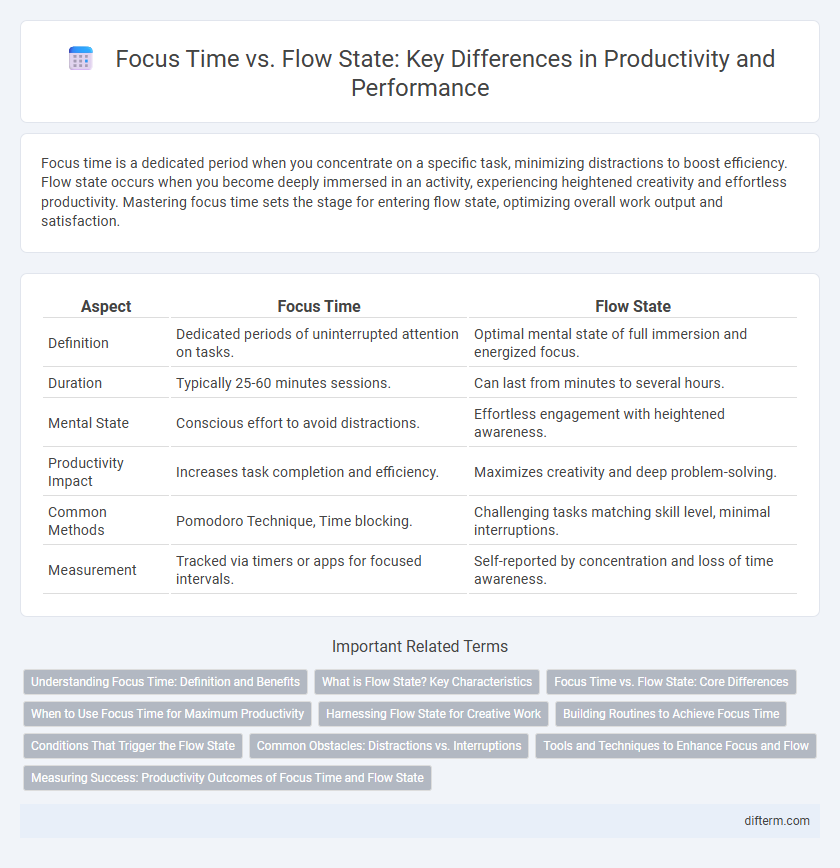Focus time is a dedicated period when you concentrate on a specific task, minimizing distractions to boost efficiency. Flow state occurs when you become deeply immersed in an activity, experiencing heightened creativity and effortless productivity. Mastering focus time sets the stage for entering flow state, optimizing overall work output and satisfaction.
Table of Comparison
| Aspect | Focus Time | Flow State |
|---|---|---|
| Definition | Dedicated periods of uninterrupted attention on tasks. | Optimal mental state of full immersion and energized focus. |
| Duration | Typically 25-60 minutes sessions. | Can last from minutes to several hours. |
| Mental State | Conscious effort to avoid distractions. | Effortless engagement with heightened awareness. |
| Productivity Impact | Increases task completion and efficiency. | Maximizes creativity and deep problem-solving. |
| Common Methods | Pomodoro Technique, Time blocking. | Challenging tasks matching skill level, minimal interruptions. |
| Measurement | Tracked via timers or apps for focused intervals. | Self-reported by concentration and loss of time awareness. |
Understanding Focus Time: Definition and Benefits
Focus time refers to dedicated periods where distractions are minimized to enhance concentration and task completion efficiency. This intentional allocation boosts cognitive performance, improves work quality, and accelerates goal achievement. Emphasizing focus time fosters sustained attention, reduces mental fatigue, and supports deeper learning and problem-solving capabilities.
What is Flow State? Key Characteristics
Flow state, often described as being "in the zone," is a mental state where individuals experience complete immersion and energized focus on the task at hand. Key characteristics include intense concentration, a sense of control, loss of self-awareness, and distorted perception of time. This state enhances productivity by making complex tasks feel effortless and boosting creativity.
Focus Time vs. Flow State: Core Differences
Focus time involves deliberately setting aside uninterrupted periods to concentrate on specific tasks, enhancing productivity through structured attention. Flow state, characterized by deep immersion and loss of self-awareness, allows for peak creative performance and heightened efficiency. The core difference lies in focus time being a planned effort to eliminate distractions, while flow state emerges spontaneously from complete engagement in an activity.
When to Use Focus Time for Maximum Productivity
Focus time is essential for tasks that require deliberate attention, such as planning, organizing, or handling complex problem-solving, where avoiding distractions maximizes efficiency. Use flow state when engaging in deep creative work or activities that benefit from sustained immersion and intrinsic motivation, leading to peak performance and innovation. Allocating focus time strategically before entering flow state can prime the brain for enhanced concentration and higher-quality output.
Harnessing Flow State for Creative Work
Harnessing flow state significantly enhances creative work by aligning deep focus with intrinsic motivation, resulting in heightened productivity and innovative outcomes. Unlike conventional focus time, flow state involves complete immersion and effortless concentration, fostering seamless idea generation and problem-solving. Prioritizing environments and habits that trigger flow can transform creative tasks into highly efficient and rewarding experiences.
Building Routines to Achieve Focus Time
Building consistent routines enhances focus time by training the brain to enter productive states more efficiently. Structured habits like fixed work hours, minimal distractions, and scheduled breaks support sustained attention and increase the likelihood of reaching flow state. Optimizing environmental cues and behavioral patterns cultivates deeper concentration and accelerates task completion.
Conditions That Trigger the Flow State
Flow state is triggered by clear goals, immediate feedback, and a balance between challenge and skill level that fully engages attention. Minimizing distractions and creating an environment that supports deep concentration enhances the conditions for sustained flow. Optimal flow also requires intrinsic motivation and a sense of control over the task, leading to heightened productivity and creative output.
Common Obstacles: Distractions vs. Interruptions
Distractions, such as notifications or background noise, fragment focus time, reducing productivity by constantly diverting attention. Interruptions, often unexpected and external, break the flow state by forcing task switching and cognitive reset. Overcoming these obstacles requires strategies like environment control and deliberate scheduling to maintain sustained, deep work periods.
Tools and Techniques to Enhance Focus and Flow
Utilizing techniques such as the Pomodoro Technique and time blocking significantly boosts focus time by breaking work into manageable intervals, reducing distractions. Tools like noise-cancelling headphones and apps such as Forest help maintain a deep work flow state by minimizing interruptions and promoting sustained concentration. Incorporating mindfulness practices and ambient soundscapes further enhances cognitive performance, enabling smoother transitions into prolonged periods of flow.
Measuring Success: Productivity Outcomes of Focus Time and Flow State
Measuring success in productivity hinges on analyzing outcomes from both focus time and flow state, where focus time offers quantifiable intervals of sustained attention yielding task completion metrics. Flow state, characterized by deep immersion and intrinsic motivation, enhances creativity and problem-solving efficiency, often reflected in quality and innovation rather than volume. Evaluating productivity requires balancing objective measures like output rate with subjective assessments of work quality and cognitive engagement during these periods.
focus time vs flow state Infographic

 difterm.com
difterm.com